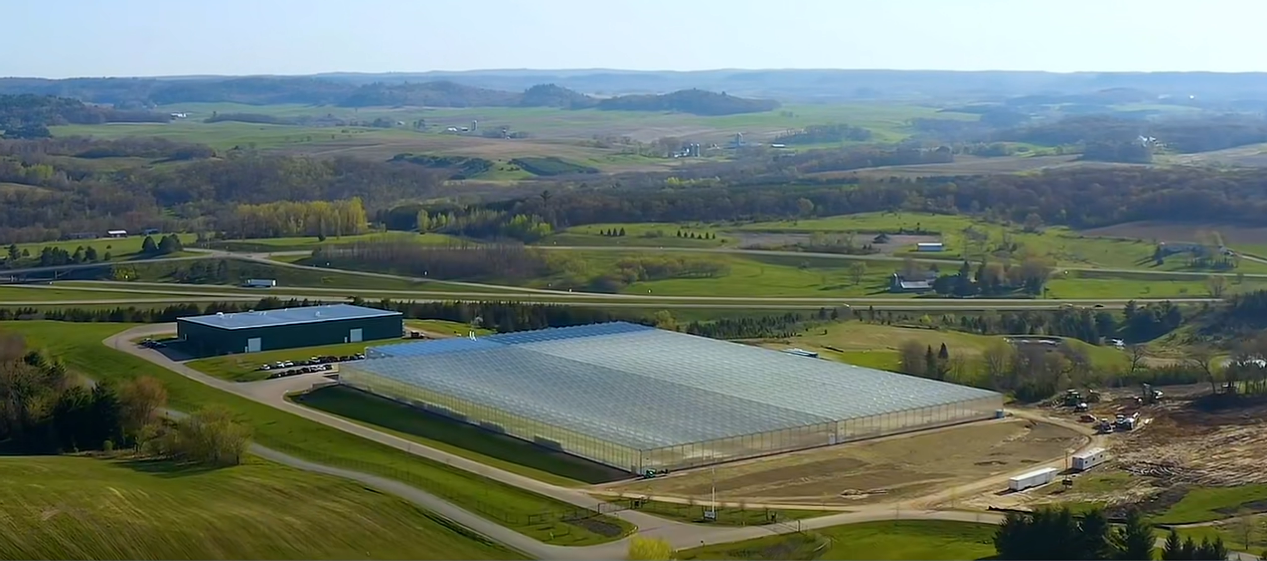Newest
Salmon-lettuce aquaponic growing system opens up new vistas for modern agriculture
 2023-09-26
2023-09-26
-- State of technological development in Agriculture in the US and in China
(By Ellie Xinning Li, Shanghai, CHINA)

Superior Fresh fish and vegetable symbiotic farm in Wisconsin, USA
Superior Fresh, a farm situated in Wisconsin, USA, known as the largest indoor salmon farm in the United States. Their fish farming operation spans six acres and yields 72,000 kilograms of Atlantic salmon annually. Additionally, they operate a 36-acre indoor vegetable farm capable of producing 900 tons of green leafy vegetables each year, which is equivalent to the output of a traditional 1800-acre farm. This farm has received organic certification from the US Department of Agriculture.The water utilized for fish farming undergoes filtration to eliminate impurities and is transformed into nitrate-rich water. This water is then recycled to supply the greenhouse with nutrients for vegetable growth. After the vegetables absorb these nutrients, the clean water is returned to the fish pond, resulting in an impressive 99.9% water recycling rate. Superior Fresh has established 600 offline stores and has a presence in 28 Whole Foods outlets in Wisconsin and Minnesota, effectively implementing a direct supply model from their farm.
In China, currently situated within the AIoT Agricultural Digital Technology Smart Farming Application Demonstration Park in Jinshan, Shanghai. This company employs soilless cultivation techniques within a controlled and intelligent greenhouse setting, utilizing factory-style production approaches to cultivate specialty vegetables, primarily. Thanks to the year-round controllable environment, they achieve an impressive annual lettuce output of 28 tons per mu, a figure 5-7 times higher than traditional land-based cultivation, and they save up to 90% of water in the process.Their system merges cutting-edge technologies like artificial intelligence and the Internet of Things with greenhouse agriculture, forming a comprehensive smart agricultural solution that combines hardware, AIoT technology, cultivation methods, and sales channels. At the heart of their intelligent greenhouse operation is their independently developed AIPaaS system (Intelligent Planting System for Facility Agriculture). While traditional farming relies heavily on skilled technicians, the AIPaaS system aids production workers and serves both managers and technicians.Within the AIPaaS system, a sophisticated weight model collects data from various sensors during agricultural production. It promptly transmits a "diary" of vegetable growth to the agricultural brain, accurately identifying crop types and production capabilities, and issuing pest and disease warnings. It also formulates precise planting and environmental control decisions to guide production.

AIoT agricultural digital technology smart agriculture application demonstration park in Jinshan, Shanghai, China
When discussing cutting-edge agricultural technology, the Netherlands stands out as a prime example. This remarkable nation has harnessed innovative greenhouse cultivation techniques to emerge as a major agricultural powerhouse. According to statistics, the Netherlands boasts a staggering glass greenhouse area exceeding 27,000 hectares, accounting for nearly a quarter of the world's total greenhouse space. The phrase "small country, big industry" aptly characterizes the economic profile of this Western European nation.Currently, the United States, the Netherlands, Germany, Japan, and Australia lead the way in advancing modern agricultural technology.
Modern agriculture represents an agricultural paradigm that has evolved through the fusion of modern industry and scientific advancements. It embodying the ideals of a green, low-carbon, and intelligent industry, with the intelligent economy at its forefront and health as its cornerstone.According to the "2023-2029 China Modern Agricultural Industry Market Development Prospect and Investment Risk Assessment Report" from Zhiyan Consulting, 2022 witnessed the global smart agricultural market reaching a substantial scale of approximately $171.75 billion, showcasing a noteworthy year-on-year growth rate of 17.73%. Across the globe, nations are actively expediting their foray into smart agriculture, further integrating artificial intelligence, big data, cloud computing, and related technologies into the agricultural landscape. It is anticipated that by 2026, the global smart agriculture market will burgeon to an impressive $341.02 billion.
The United States government places significant emphasis on high-tech advancements, particularly in the realms of agricultural. It actively supports the integration of high-tech solutions into agriculture. Through fiscal investments, the federal government has established an agricultural information platform. To streamline the collection and processing of agricultural data, it has also founded a national agricultural and rural science and technology information center. At the strategic level, the U.S. government has taken the lead in organizing collaborations with various professional associations and decision-making advisory bodies, forming a robust civil agricultural social service system. In terms of financial support, the federal government annually allocates over $1 billion in funding for agricultural information, constituting 10% of agricultural administrative expenses.
The China government places significant emphasis on advancing modern agriculture. In terms of top-level design, relevant government departments in China have released key documents, including the National Modern Facility Agriculture Construction Plan (2023-2030), along with the Guidance of the Ministry of Agriculture and Rural Affairs on the Development of Modern Facility Agriculture and the Implementation Plan for the Modernization of Facility Agriculture (2023-2025). Regarding financial support, the Chinese government has initiated a pilot program offering discounted loans for modern facility agriculture construction projects in 15 provinces and the Beidahuang Agricultural Reclamation Group Co., Ltd. In tandem with a 1.5 billion yuan central financial assistance fund, there is a concerted effort to accelerate the development of centralized seedling nursery facilities in the southern region.
In summary, both the United States and China have much to learn from the Netherlands in the realms of agricultural facility technology, auction systems, and supply chain networks. These elements have not only established the Netherlands as a global agricultural powerhouse but also serve as a guiding "compass" and an invaluable "textbook" for the advancement of modern agriculture worldwide. It is imperative that we dedicate our efforts to the development of environmentally-friendly, low-carbon, healthy, and secure modern agriculture, striving for the betterment of society and the promotion of a healthier life for all of humanity.
(By Ellie Xinning Li, Shanghai, CHINA)




